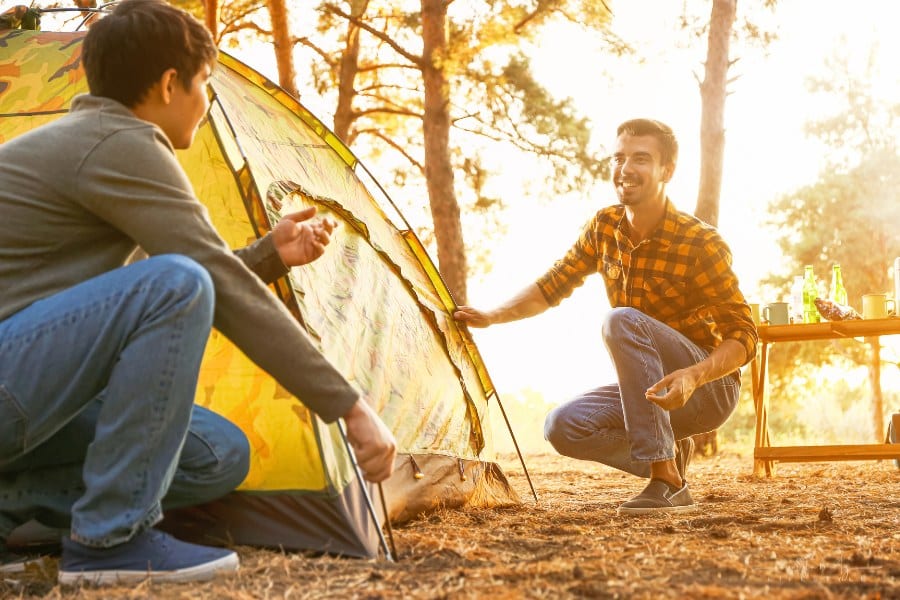How to Set Up a Campsite Like a Pro
Camping is an activity beloved by many, a great way to explore nature and enjoy the outdoors.
However, camping isn’t as simple as just pitching a tent and sitting down around the fire: putting together a campsite that operates smoothly and effectively requires certain know-how, which can be hard to come by if you’re mostly unfamiliar with how it works.
Therefore, let’s talk about the nuts and bolts of setting up a campsite like an experienced pro; this blog post will detail all of the techniques you need to become proficient in assembling your well-managed spot of outdoor real estate!
Set Up a Campsite

Select the Perfect Campsite
The most important factors when selecting a campsite include elevation, terrain, and close amenities. Elevation not only affects temperatures but also helps ensure a more comfortable sleep by blocking the wind.
Next, consider terrain — flat areas provide the best spots for camping because they remain level despite seasonal changes in conditions. Finally, check out nearby amenities such as freshwater sources and bathrooms.
Having these within easy access to your campsite will make the camping experience much more enjoyable.
Also, decorating your campsite is a great way to add personality and make it more comfortable. If you’re feeling creative, try adding colorful rugs, blankets, and pillows to your setup.
Finding the best campsite can take time, but taking the time to find one that meets all of your needs is worth it for an enjoyable camping experience.
Assemble Your Gear
Before your adventure begins, be sure to assemble all the necessary items you will need while at the campsite.
This includes tents and sleeping bags for comfortable sleeping arrangements, flashlights and lanterns to guide you throughout your stay, and cooking supplies including a stove, pots and pans, utensils, and prep items.
Also don’t forget any supplies to build a fire such as matches or a lighter as well as sticks, stones, and other materials if needed.
Additionally, make sure to pack any food and drinks you will need during your stay—there could be a variety of snacks to keep you energized throughout the day or full meals for dinner.
Finally, don’t forget to bring your camera and any outdoor activities you plan on taking part in such as fishing rods or a Frisbee.
Create a Cooking Area
Creating a cooking area in a campground can be challenging, but with a few simple tips, it can be easy. To make the process more efficient, create natural wind blocks by using rocks or trees around your camping stove for added protection from the elements.
When selecting where to place your stove, look for level ground to ensure balance and prevent flipping.
Once you have decided on the set-up of your cooking area, make sure you bring dishes that are easy to clean like reusable plastic containers or stainless steel cutlery.
Doing so will not only reduce waste and help conserve the environment but also make packing up the campsite an absolute breeze!
Prepare for Wildlife
Establishing a safe campground is a must when camping in areas where wildlife may be present. It’s important to plan, adhere to various safety protocols, and familiarize yourself with local laws to prevent any unwanted surprises.
The primary safety precaution for wild animals is to not feed them! In addition, avoid leaving food uncomfortably close to your campsite or straying too far from camp without bear spray.
As an extra layer of protection, remember to store all uneaten food overnight in airtight containers and dispose of it the following morning.
By taking these precautions and following local regulations, you can ensure an enjoyable and worry-free camping experience while still being respectful of the natural wildlife!
Ways to Dispose of Waste Properly
Knowing how to dispose of waste properly while camping is critical for protecting the natural environment, as well as ensuring a pleasant and safe experience for everyone.
It’s always a good idea to practice the ‘leave no trace’ mantra when outdoors — this means to carry in and carry out all non-biodegradable materials with you when leaving the campsite, and to bury human waste at least six inches deep when possible.
As long as you are mindful of disposing of your trash appropriately and following local regulations, your time spent camping can provide plenty of rewarding adventures amongst nature.
Camping is the perfect way to reconnect with nature, strengthen connections with family and friends, and enjoy all that the great outdoors has to offer.
With the help of this workflow, you’ll be able to transform a simple campsite into your adventure.
But don’t forget to keep in mind how to prepare for wildlife, and dispose of your trash properly when leaving so that others may benefit from its beauty as well.


